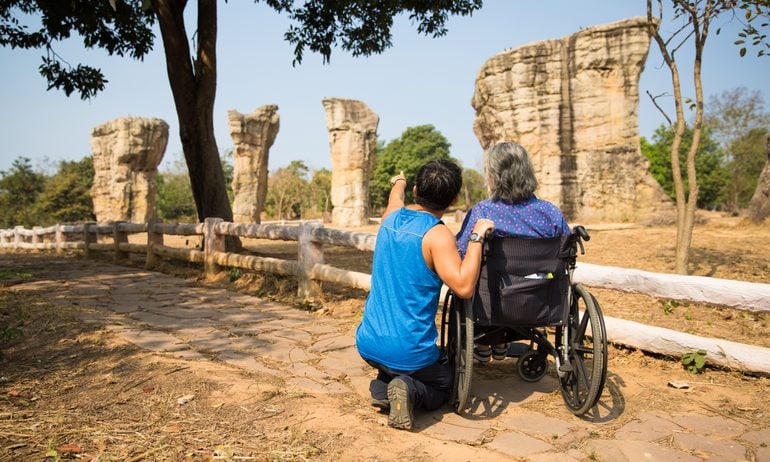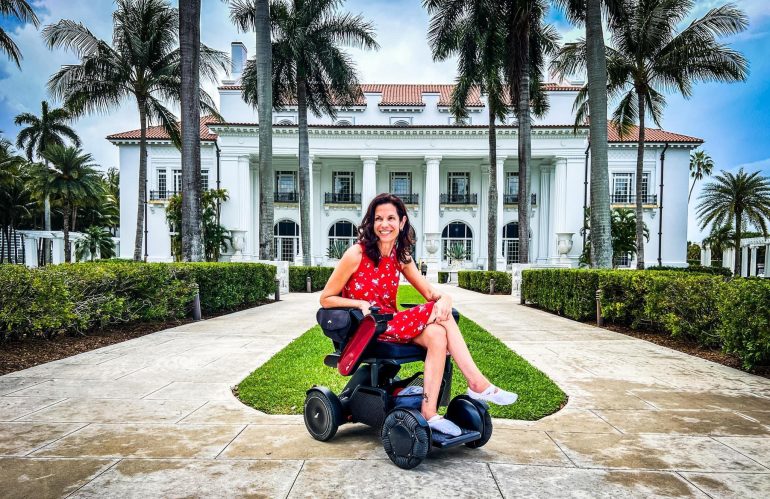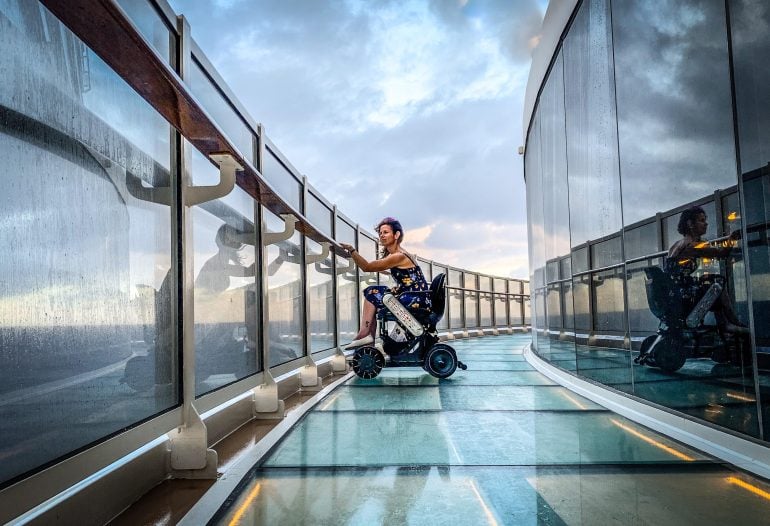What Everyone Can Learn From a Traveler With a Disability
Sylvia Longmire writes about traveling with a disability on her blog Spin the Globe.

Many or all of the products on this page are from partners who compensate us when you click to or take an action on their website, but this does not influence our evaluations or ratings. Our opinions are our own.
Like many people who trek up Mount Etna in Sicily, Sylvia Longmire wanted to see the top of an active volcano. And overlooking the black crater, she thought, “This would make a great Instagram photo.” And it was a great photo — until she realized she was stuck.
Longmire, who has multiple sclerosis, uses a power wheelchair full time. Its wheels were caked in volcanic mud.
But being stuck on top of a volcano is what Longmire calls a simple problem. It’s the hotel rooms that aren’t as advertised and the long flight delays that really cause big issues. Though largely for different reasons than for people without disabilities, these inconveniences are a huge headache all the same.
With airline and hotel staffing shortages, coupled with high travel demand, travelers are experiencing more delays and problems. And travelers with disabilities are experts at dealing with the unexpected. According to the most recent data from the National Household Travel Survey, an estimated 25.5 million Americans have disabilities that make traveling outside the home difficult. Longmire has been traveling solo in a wheelchair and writing about accessibility travel on her blog, Spin the Globe, for the past seven years.

Sylvia Longmire was diagnosed with multiple sclerosis in 2005 and continues to travel the world. (Photo courtesy of Sylvia Longmire)
Here are some of her tips and how you can apply them to your own trip planning, whether or not you’re traveling with someone who has a disability or limited mobility.
1. Plan the trip backward
Longmire says planning a trip for her and her two sons is almost the opposite of how nondisabled people plan to travel.
Instead of first booking flights, Longmire starts with what she’ll do at her destination. For a Paris trip, for example, she has to look up whether her ideal activities — visiting the Eiffel Tower and the Louvre, say — are accessible. Then, she has to figure out how she might be able to get to those places. Do the taxis have wheelchair lifts? Can she wheel over from nearby hotels?
After she’s established there’s enough to do in a destination and feasible ways to get around, she’ll then work on booking accommodations and flights.
Checking the availability and accessibility of local attractions is good advice for any traveler, particularly because the influx of tourists this year could make your dream trip a total bust. Rental car prices could be prohibitively expensive or reservations might be totally booked for the dates you are traveling. Booking backward can help you accomplish your travel goals and save money along the way by reserving early.
2. Confirm the details
Longmire spends many hours poring over the details to make her trips go as smoothly as possible.
“There's nothing consolidated,” Longmire says. “So I have to go to the website for every museum, for every attraction. I have to make phone calls. I'll read through other people's blogs.”
In the U.S., the Americans with Disabilities Act requires businesses like hotels and restaurants, along with public transit and shuttle services, to comply with certain design standards to make them accessible. There aren't always accessibility standards in other countries, though.
Longmire will use the street view on Google Maps or find YouTube videos to go on virtual tours. She’ll read blogs and forum posts from other disabled travelers, and she’ll call or email businesses to confirm what she can expect when she visits.
Every traveler, particularly ones that rely on online travel agencies and third-party sources, could certainly avoid some mishaps by contacting their travel provider to confirm details.
3. Have a flexible mindset
No amount of planning is going to guarantee you an easy, hassle-free travel experience. But one thing that will help is being open-minded.
“I've spent hundreds of nights in accessible hotel rooms around the world,” Longmire says. “And every time I open that hotel room door, I never know what I'm going to get because most hotel rooms, even in the U.S., have some sort of ADA problem that is noncompliant.”
Accepting that things may not go according to plan can help you minimize the stress. Plus, you can buy travel insurance or take other steps to protect yourself knowing that difficulties may arise.
In Longmire’s case, those difficulties can sometimes be extreme. For example, bathrooms on airplanes aren’t big enough for her wheelchair, and flight attendants can’t always help get her there.
“I dehydrate and starve myself about 24 hours before I fly,” explains Longmire, who lives in Florida. “A lot of us do that because I can't use a bathroom on a plane. Like if I have to fly five hours to L.A., I can't use the bathroom. I have to hold it.”
4. Universal design is good design
While airplanes were not well-designed for people in wheelchairs, destinations that are accessible can be a good vacation for everyone.
“If you put a ramp somewhere, it's not just me that's using their ramp.” Longmire says. “It's anybody, whether it's older people or parents with kids in strollers.”
If you’re traveling with grandparents, grandkids or anyone with limited mobility, planning a trip that meets their needs will usually accommodate everyone. And it can be cheaper, too. For instance, Longmire recommends looking for cruises that offer accessible excursions because it’s less expensive than hiring a private accessible tour operator exclusively for your family.
5. Fight your travel fears bit by bit

Sylvia Longmire has traveled to 48 countries and counting in her power wheelchair. (Photo courtesy of Sylvia Longmire)
There’s a special type of fearmongering aimed specifically at anxious travelers. They’ll see news reports of extremely long security lines and thousands of canceled flights, and vow to book a trip when things have calmed down.
But Longmire has never let the fear hold her back.
“The No. 1 deterrent to traveling with a disability is not logistics, it's not money, it's not the physical disability. It's fear,” she says.
She recommends building up your confidence slowly. Take public transportation and stay at a hotel in your own city. Work your way up to road trips and short flights.
“The more that you do this, the more comfortable you get with it and you understand what the process is because you've already been through it,” Longmire says.
Longmire has been through volcanic mud and more, and she believes it was all worth it.
Chase Sapphire Preferred® Card
Travel
Dining
🔥 Huge highest-ever bonus on NerdWallet's 2025 Best All-Purpose Travel Rewards Card is back. Don't miss your rare chance to: Earn 100,000 points when you spend $5,000 on purchases in the first three months. That's worth at least $1,250 toward travel booked through Chase.


